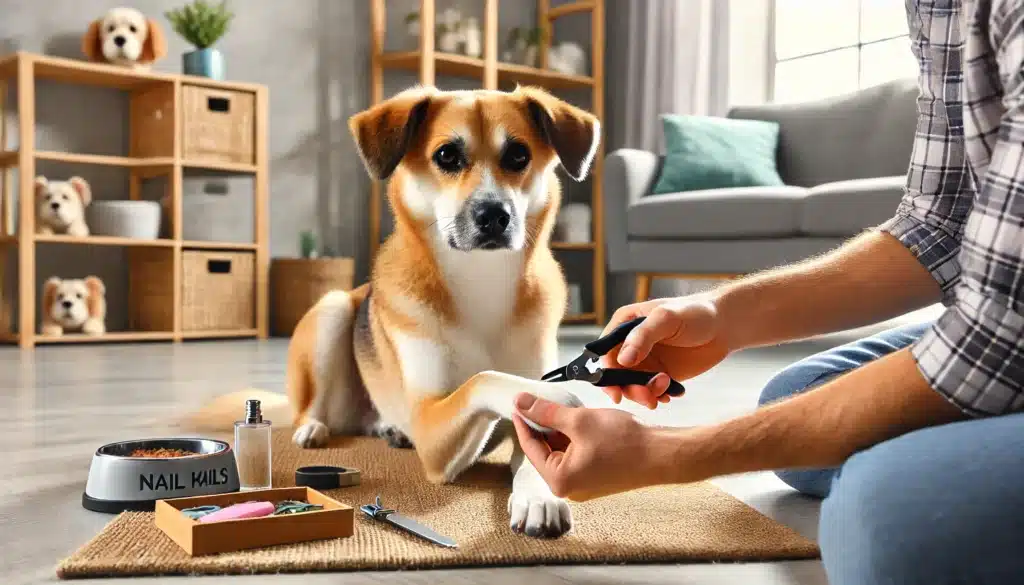Trimming your dog’s nails can feel intimidating, especially if you’ve never done it before. The fear of cutting too short and hurting your dog is very real — but with the right knowledge and tools, nail trimming becomes a safe, manageable, and essential part of your dog’s grooming routine.
In this guide, you’ll learn why nail care matters, how often to trim, step-by-step instructions, and expert tips for a smooth experience.
Why Nail Trimming Matters
When a dog’s nails grow too long, they don’t just click on the floor — they can cause real discomfort and health issues:
- Pain when walking
- Altered posture or gait
- Cracked or split nails
- Injuries from nails snagging on fabric or surfaces
- Risk of infection in overgrown nails
Long nails can even affect your dog’s joints over time. Trimming them regularly helps your dog stay active, balanced, and pain-free.
How Often Should You Trim?
This depends on your dog’s breed, activity level, and environment.
| Dog Type | Nail Trimming Frequency |
|---|---|
| Active dogs (frequent walks on pavement) | Every 4–6 weeks |
| Indoor or less active dogs | Every 2–3 weeks |
| Small breeds with fast nail growth | Every 2 weeks |
Pro tip: If you hear clicking on hard floors, it’s time for a trim.
What You’ll Need
- Dog nail clippers (guillotine or scissor type)
- Styptic powder or pencil (to stop bleeding if you cut too short)
- Nail file or grinder (for smoothing edges)
- Treats and praise for positive reinforcement
- A flashlight (for light-colored nails)
- A calm, quiet environment
Avoid using human nail clippers — they aren’t designed for canine claws and can split the nail.
Step-by-Step: How to Trim Your Dog’s Nails
1. Choose a Quiet Space
Minimize distractions. Sit on the floor or place your small dog on a secure surface. If your dog is anxious, consider doing one paw at a time over a few sessions.
2. Familiarize Your Dog with the Clippers
Let your dog sniff the clippers and hear the sound. Offer treats and praise without trimming yet. This helps build a positive association.
3. Identify the Quick
The quick is the pinkish part inside the nail — it contains blood vessels and nerves.
- In light-colored nails, the quick is visible.
- In dark nails, use a flashlight or trim small bits at a time.
Avoid cutting into the quick — it’s painful and causes bleeding.
4. Trim at a 45-Degree Angle
Hold the paw gently but firmly. Trim in small increments, aiming at a 45-degree angle away from the paw pad. Stop when you see a white center with a small black dot (for dark nails) — that’s just before the quick.
5. Use Styptic Powder if Bleeding Occurs
If you accidentally cut too far:
- Stay calm
- Apply styptic powder or pencil
- Hold gentle pressure
- Reassure your dog
Bleeding usually stops quickly and isn’t serious, but your dog may become nervous. Offer comfort and pause the session if needed.
6. Smooth the Edges
Use a nail file or grinder to soften rough edges and prevent scratching.
7. Reward and Praise
Celebrate the experience with treats, belly rubs, or playtime. Your dog will start to associate nail trimming with something positive.
Tips for Easier Nail Trimming
- Start young: Handle your puppy’s paws early and often
- Keep sessions short: One paw at a time is okay
- Use peanut butter on a lick mat: Keeps your dog distracted
- Stay calm and patient: Your energy influences your dog’s behavior
- Enlist a helper: One person can hold while the other trims
- Use a dremel-style grinder: If your dog tolerates the sound
What If My Dog Refuses?
If your dog is fearful or resists, try:
- Desensitization: Touch the paws daily without trimming
- Gradual steps: Practice just holding the clippers near the paw
- Training sessions: Use clicker training to reward calm behavior
- Professional help: Groomers or vets can trim safely and quickly
Never force the process — it can increase fear. Always work toward cooperation, not control.
When to Let the Pros Handle It
Consider a groomer or vet if:
- Your dog becomes aggressive or panicked
- You’ve had repeated bleeding incidents
- Your dog’s nails are severely overgrown
- You don’t feel confident trimming yourself
Professionals can also show you proper technique for future at-home care.
Final Thoughts: Healthy Nails, Happy Steps
Trimming your dog’s nails is a key part of their wellness routine. It doesn’t have to be a stressful experience — with knowledge, the right tools, and a calm approach, it becomes just another act of love and care.
Start slowly, stay consistent, and always prioritize your dog’s comfort. You’ll both feel more confident with every session, one paw at a time.







